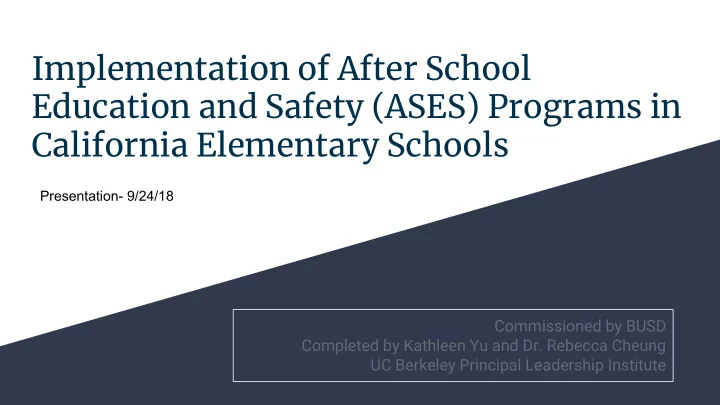

Implementation of After School Education and Safety (ASES) Programs in California Elementary Schools Presentation- 9/24/18 Commissioned by BUSD Completed by Kathleen Yu and Dr. Rebecca Cheung UC Berkeley Principal Leadership Institute
ASES Program Purpose ● Overseen by the CA Department of Education ● Funds the establishment of local after school education and enrichment programs. ● Programs must be created through partnerships between schools and local community resources to provide literacy, academic enrichment and safe constructive alternatives for students in kindergarten through ninth grade (K-9). ● The current funding level for the ASES program is $550 million.
ASES Program Purpose After school programs must consist of the two elements: ● An educational and literacy element- must provide tutoring and/or homework assistance designed to help students meet state standards in one or more of the following core academic subjects: reading/language arts, mathematics, history and social studies, or science. ● An educational enrichment element- must offer an array of additional services, programs, and activities that reinforce and complement the school’s academic program.
Context of Study ● Examines and summarizes the design and implementation of ASES programs of selected elementary schools in CA for the purpose of informing Berkeley Unified School District’s (BUSD) extended learning committee ● Report is not an evaluation of BUSD’s extended learning programs nor is it an evaluation of the ASES program school sites ● An attempt to gather relevant information to inform BUSD’s plans for their extended learning program
Method ● Short timeline ● Relied heavily on internet research and publicly accessible information ● Sampling Criteria: ○ Elementary programs ○ Urban location ○ Diverse student population ○ Amount of ASES funding received ○ Existence of economic integration ○ Size of district
Districts in Final Sample ● Alameda Unified (AUSD) ● San Leandro Unified (SLUSD) ● San Juan Unified (SJUSD) - Near Sacramento ● San Francisco Unified (SFUSD) ● Redwood City School District (RCSD) ● Santa Barbara Unified (SBUSD) ● Santa Rosa City Schools (SRCS).
Three Models of Partnership Co-Sponsorship Subcontracting School District Centered Relationship District hires a CBO to between district carry out the majority of Programs are run by and community the activities. district staff and partner is equal CBO’s focus (AUSD, SLUSD, RCSD, primarily on (SFUSD) SRCS) enrichment. (SBUSD, SJUSD)
Connections to BUSD It is our understanding that We did not have any school BUSD has both districts in our sample with subcontracting and school two models occurring district centered ASES simultaneously. programs.
General Issues ● Funding is both constrained and in jeopardy ○ Threat of federal “de-funding” of 21st CCLC programs ○ Current ASES funding has not changed since 2006 despite rising costs ● Funding constraints impact staffing ○ High turnover ○ Low staff qualification requirements ○ Little professional development opportunities
● Great unmet needs for after school General Issues programming continued ○ Recent requests for ASES and 21st CCLC funding exceeded $143 million than available ○ More than half of all programs turn away students due to capacity ○ English Learners among those most underserved
● Lack of comprehensive database for General Issues ASES data continued ○ No common quality indicators/ dashboard ○ No public reporting requirements for websites
2012 ASES System-wide Evaluation Themes ● Most common reason parents enrolled children is to provide academic support ● Most commonly offered activities were academic enrichment, homework assistance, math, language arts, art.music, PE/sports, and recreation ● Target population was at-risk students
2012 ASES System-wide Evaluation Implementation Strategies ● Ensure regular attendance ● Strengthen partnership between school day and after school program ● Create developmentally appropriate programming ● Consider the implementation of After School Quality Standards
Discussion How does this presentation/report inform the work of the BUSD Extended Learning Committee?
Recommend
More recommend